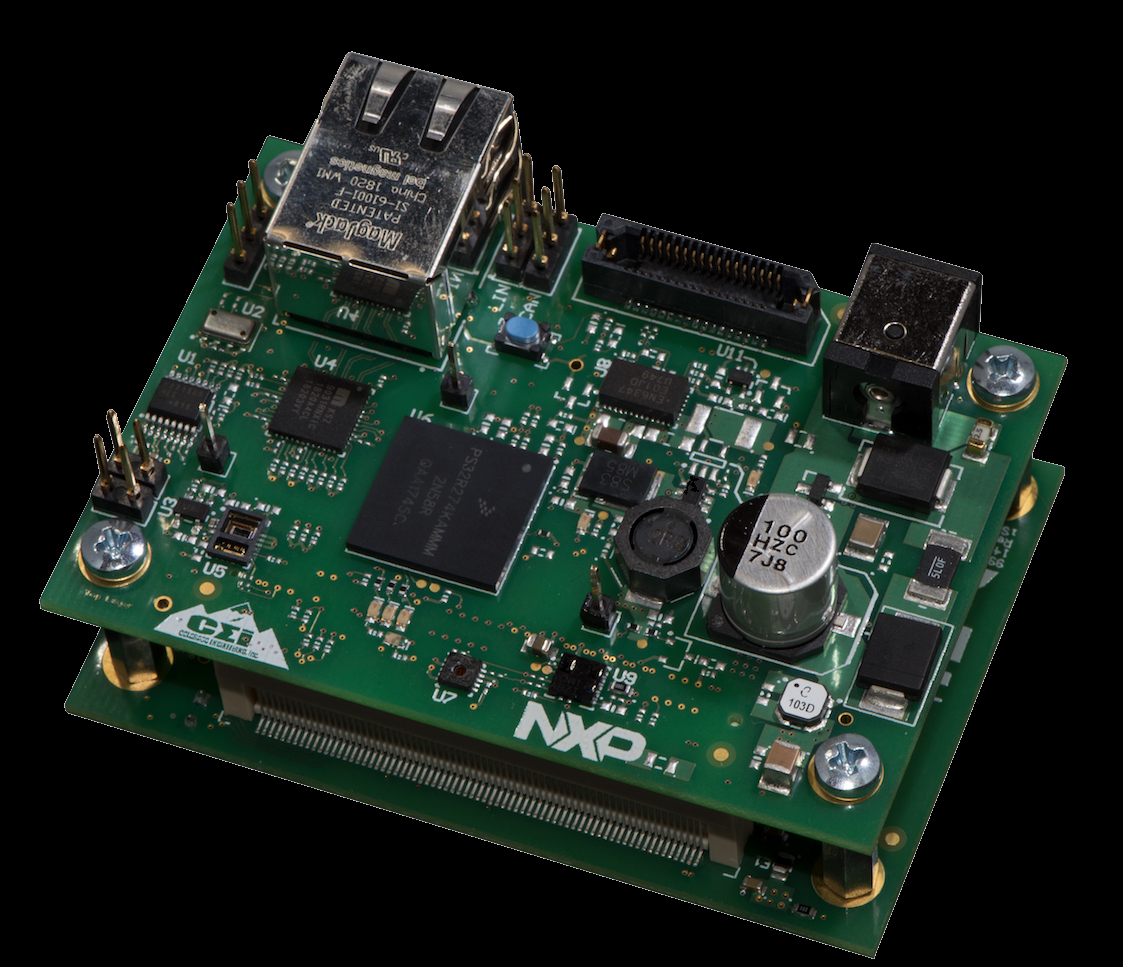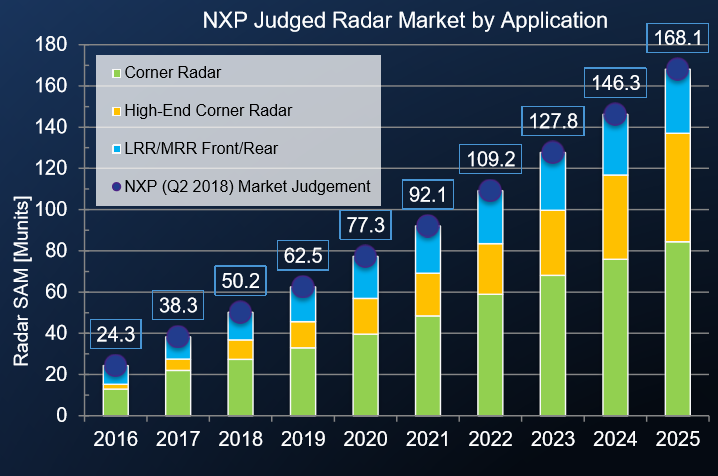Subscribe to the channels:
@AutomotiveRu - auto industry news, hardware and driving psychology
@TeslaHackers - a community of Russian Tesla hackers, rental and drift training on Tesla
From 2018 to 2022, a total of 375 million radars will be installed on new cars. What problems can arise with these systems?
Now that Regional New Car Assessment Programs (NCAP) require Adaptive Cruise Control (ACC) and Emergency Braking (AEB) features to give their five-star safety ratings, NXP Semiconductors is urging the automotive industry to take over radar systems.

Car sensors
To accelerate the integration of radars into modern ADAS, on Tuesday (October 2), NXP released a solution combining S32R processors, an RF transceiver and an antenna on a new reference platform. Developed in partnership with Colorado Engineering, this platform meets “the stringent requirements for industry functionality, performance and security,” NXP said.
The new system was designed to dispel the myth of the "intricacy" of radars, which usually requires large automotive OEMs to fine tune the antenna and analog designs. NXP hopes that its “non-standard” car radar system will be able to serve Chinese automakers who still need a few years to catch up with the car market in the rest of the world.
In a recent phone interview with the EE Times, Kamal Khouri, vice president and general manager of ADAS at NXP, told us, “Radar has become the preferred sensor” for ACC and AEB. “Cameras can't measure speed like radars can,” he explained. “Thanks to the reflection of signals, radars can also see around corners. On the other hand, lidars that don't use moving parts are still very expensive. ”
However, it is well known that traditional radar lacks resolution and cannot distinguish between nearby objects. What's more, radars are notorious for having false positives and not processing information fast enough to be useful on the highway.
Khoury made it clear that NXP does not believe radars will replace cameras. "The combination of cameras and radar imaging provides redundancy that makes cars safer," said Khoury.
Parsing a new radar solution
So what does the new solution from NXP entail?
The reference design, dubbed the RDK-S32R274, combines NXP's S32R27 processor, TEF810x CMOS transceiver, FS8410 power management IC, and radar software development kit. NXP has added expansion modules and antenna modules that can be optimized to create a custom development platform for specific client applications.
At the heart of the radar solution is a scalable family of Power Architecture-based processors - the S32R27 and S32R37, which Khoury described as "the first chips designed to handle radar algorithms."

S32R NXP block diagram
According to Roger Keane, radar manager at ADAS for automotive microprocessors, NXP's radar IP processing is done on their own processors, in addition to automotive-grade software for ACC and AEB. Board and antenna modules designed for the company's radar solutions are "reliable as certified automotive systems."
With NXP's automotive radar SDK, developers who used to manually configure their own radar IP processors for specific hardware can now use NXP's radar functionality, Keen explained.
The S32R27 based solution is designed for advanced applications such as ACC and AEB. S32R37, with less processing power than S32R27, is compatible with the source code and optimized for operations such as detection of blind spots.
The cost of the S32R27 version is $ 14-17 (price with the purchase of 1000 modules). The cost of the solution based on S32R37 is 10-12 dollars.
Market competition
NXP is not alone in integrating vehicle radars. Ian Riches, executive director of global automotive practice at Strategy Analytics, considers NXP and Infineon to be among the leaders in automotive radar.
Meanwhile, Texas Instruments, which recently entered the radar market, began to catch up with the market in 2017, introducing millimeter-wave radar chips built on its own standard CMOS RF technology. TI told us that its radar chips provide "resolution accuracy of less than 5 cm, detection range of up to hundreds of meters and speed of up to 300 km / h." An even more important factor that distinguishes TI is that their microcircuit combines wave devices using mmWave technology with a 76-81 GHz wave radar, a microcontroller (MCU), and digital signal processor (DSP) cores on a single chip.
TI chose this approach because a higher level of embeddedness can reduce footprint, power consumption and cost without sacrificing performance. Cédric Malaquin, RF Market Analyst and Technology Company at Yole Développement, told us that while NXP took the first step by developing its RF-CMOS RF transceiver, TI has gone further by integrating DSP into your radar chip. Malakin claims that the DSP integration allows TI to reduce the radar footprint by almost 60%. DSP is the key to the "signal processing chain for object detection and classification".
Nonetheless, NXP defended the company's two-chip solution (radar chip + microprocessor), highlighting that this approach offers customers much more scalability and flexibility for radar integration.

NXP Radar Solution: The NXP
Kin Antenna Side said the following: “Consider operating at 43 ° C in Arizona.” He also stated that positioning the transceiver chips away from the microprocessor, for example, makes it easier to manage thermal conditions when radars are installed in bumpers.

NXP radar solution: processor side
Keen also added that the NXP approach - the use of processors specifically designed for IP radar processing increased the performance per watt for radar solutions. Under pressure over the benchmark used to analyze performance per watt, NXP said it was gathering information "from open data" and "confidential customer meetings." But Keane added, "While we achieved the best performance per watt we've ever seen, we have anchored the broader industry requirements for third-party testing."
When asked to compare TI's chips to NXP's solutions, Riches of Strategy Analytics noted that "in fact, TI's approach has the potential to offer lower cost, but at the same time slightly less flexibility."
Market Forecast
Radar suppliers and market research firms are optimistic about the growing demand for vehicle radars.
Different applications of radars require the creation of many different radar modules. NXP told us that “typically two radar modules are used in the two rear corners of a vehicle to detect blind spots. In more advanced applications (like cross-traffic detection), two more radar modules are required for the front corners of the vehicle. "
NXP claims that in long-range radar applications, one module is typically installed somewhere in the front bumper.
Strategy Analytics predicts a total of 375 million radars will be installed on new passenger cars from 2018 to 2022. Riches believes 107 million radars will be installed in 2022.

NXP estimates on the radar market by area of application
According to NXP estimates, in 2022, 109.2 million units of radars will be delivered - from angular to high-tech angular and long-range / medium-range models, including front / rear radars, which led to the introduction of radars in 50% of all new cars.
Radars Building Images
The newest trend among new radar solutions is how the most efficient radar systems can generate a high-resolution “image” that can both locate and identify / classify objects in the field of view. According to Strategy Analytics' Riches, "today's radars used in vehicles do not have the required resolution to display the correct image with sufficient field of view."
This goal cannot be achieved with radar chips alone. Riches explained, "Antenna design is very important and this is one of the reasons we have seen startups like Metawave receive funding from companies like Infineon, Denso, Toyota AI Ventures, Hyundai Motor Company and Asahi Glass (among others)."
Radar hazard
The advantages of radar technology are well known, especially their ability to work in any weather conditions. Automotive experts believe that radars can work with computer vision sensors and form a bunch to detect critical situations in highly automated vehicles.
Riches of Strategy Analytics explained:
In fact, they operate at very different wavelengths. Cameras (obviously) use visible light and therefore perform worst in the dark, in very high contrast lighting conditions (such as when exiting a tunnel), or in heavy rain / snow. Lidars emit light outside the normal visible spectrum, but have their greatest problems in bright sunlight, which gives the system a lower signal-to-noise ratio. High-resolution lidar technology is now also expensive and less mature in the automotive industry than cameras or radars.
In turn, he noted that the radars "are immune to lighting conditions, while they have good penetration ability during rain or snow."
However, radar is not the ultimate solution. The main disadvantage of radar today is its low resolution: “it is good at saying that an object is present, but it will not be able to recognize that object," Riches said.
Simply put, radar technology may not be suitable for “making an informed decision whether to continue driving (for example, an overhead street sign was found) or to apply emergency braking (a fire engine is parked in the lane ahead). ”
This all explains why modern car radars sometimes throw and ignore stationary objects. “Radar can't tell if an object is something you don't want to bump into,” Riches lamented.
In fact, the operating manuals are full of warnings for drivers whose vehicles are equipped with radar. Riches gave several examples.
The following text is taken from the manual for of Skoda the Superb (which Utilized ACC based radars):
»ACC does not respond when approaching stationary obstacles such as traffic jams, damaged or standing at the traffic light vehicles" (page 236.).
Operating Instructions Volvo XC90 contains similar warnings:
“Distance Alert operates at speeds above 30 km / h (20 mph) and only responds to vehicles ahead in the same direction as your vehicle. Distance information is not provided for oncoming, slow-moving or stationary vehicles. ” (Page 289)
"Pilot Assist does not brake in front of people, animals, objects, small vehicles (eg bicycles and motorcycles), low trailers, or oncoming, slow or stationary vehicles." (Page 310)
Riches concludes: “You will find similar text in many other operating manuals from many other brands. The purpose of high resolution radars is to fix this problem. "
Subscribe to channels:
@TeslaHackers — Tesla-, Tesla
@AutomotiveRu — ,

: